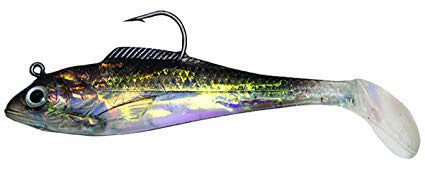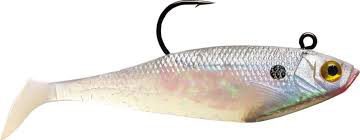Product Reviews – Swimbaits for Larger Trout
When it comes to fall speckled trout fishing in the Carolinas, we always seem to find the same few tried and true offerings hanging from our rod tips. Disregarding hot color patterns that change from season to season, MirrOlures, D.O.A. shrimp, X-Raps, and 4” soft plastic/jig head combinations comprise the majority of tackle sales, as well as trout ending up in the net.
With that being said, a previously overlooked bait has become a local staple due to not only its effectiveness, but also its consistency in producing bites from much larger trout.
No, they’re not the newest, shiniest lures to hit the market—these swimbaits have always been popular in striper fisheries to our north and snook fisheries to our south. In fact, they’ve been on local tackle shops’ shelves all along, mainly used in the river for stripers.
Comprised of a soft-plastic, paddle tail body with a molded-in keel weighted hook, swimbaits are known for their hard-thumping swimming action that is true straight out of the package. They are available from 2-6” long, with the 4-5” models being the best for our area.
That thumping, swimming action is the key to success when using swimbaits for trout, and it is important to view and fish them much differently than a traditional paddle tail. Because their keel weights make them fairly heavy lures, a traditional jigging approach is not effective because of their rapid sink rate.
To get bit, a slow and steady retrieve with an occasional rod lift is the key. This can best be compared to fishing lipless crankbaits such as Rat-L-Traps, or like fishing a MirrOlure slightly faster.
The goal is to fish the bait as slow as possible while keeping it a foot or two above the bottom.
Swimbaits fish well both across and coming back into the current, rigged with 15 lb. braided mainline and 20 lb. fluorocarbon leader.
To fish in really deep holes, swimbaits can be allowed to sink at the beginning of the cast, even in heavy current areas up to 20’. By positioning the boat on the shallow side of the drop-off, they stay in the strike zone for the entire retrieve. The slow, steady retrieve makes this a great bait for beginning anglers and kids, as long as they have the patience to fish it slow enough.
While several companies produce this style of bait, the three most popular are made by Storm, Tsunami, and Billy Bay—and they each have their place.
Storm’s offering is the most durable of the three, and it’s also the heaviest. It is best suited for heavier current and deeper water situations.
While the Tsunami weighs about the same, its different shape rides up in the water column and is perfect for medium current and depths up to 10’. It also makes a great bait from the surf, since it’s heavy enough to cast but rides higher in the water.
The Billy Bay Halo Shad is the lightest and softest in the bunch. While not as durable, especially around pinfish and other smaller fish, it definitely has the most action of the three. This makes it a better offering for finesse and shallow water situations, as long as the Billy Bay is fished on lighter (12-15 lb.) leader.
For all three, pearl white is the most popular color, followed by firetiger and chartreuse.
Everyone fishing inshore this fall knows just how many trout are around, and trout anglers are also sure to know that the majority of them are 13-15”. Swimbaits provide not only a bigger bait, but one that is often heavy enough to get below the schoolies and stay in the strike zone where the “bigguns” lurk.
If you’re looking for that citation-sized fish amid a waterway full of small ones, pick up a few swimbaits and start cranking…slowly.
